#circumzenithal arc
Text
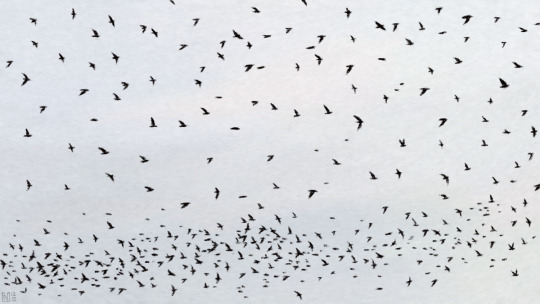
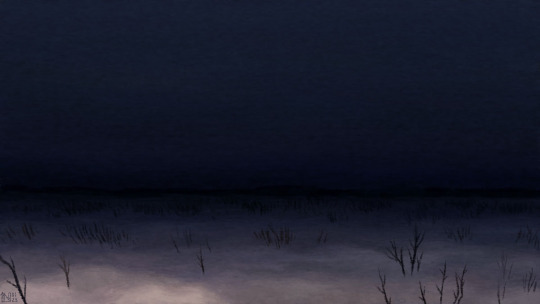

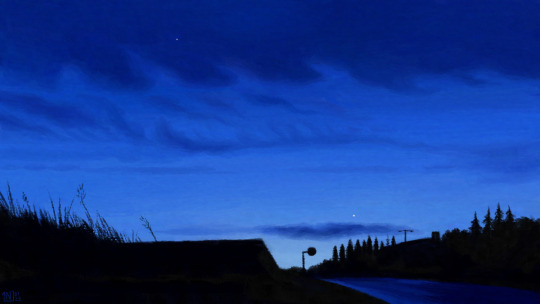
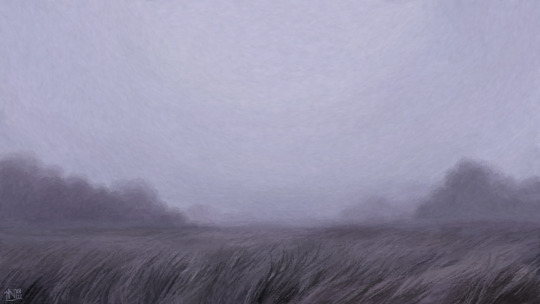
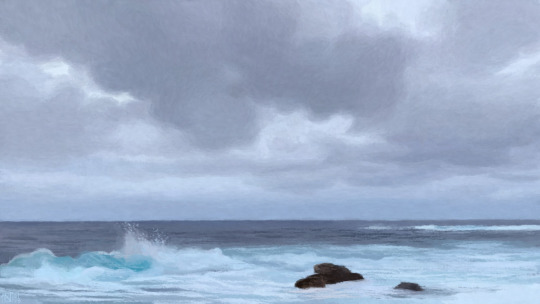
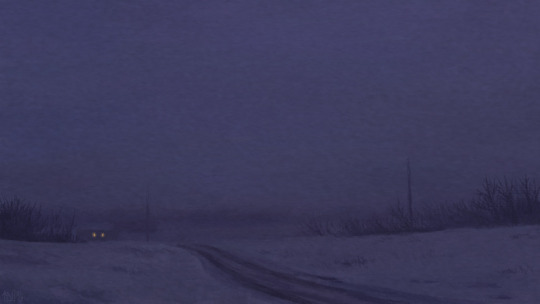
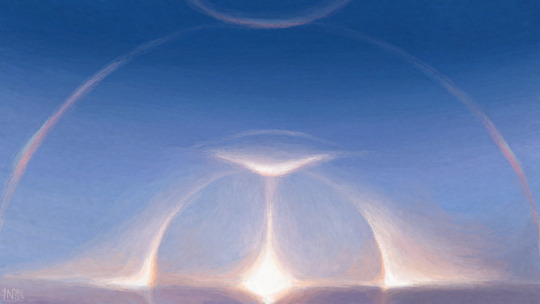
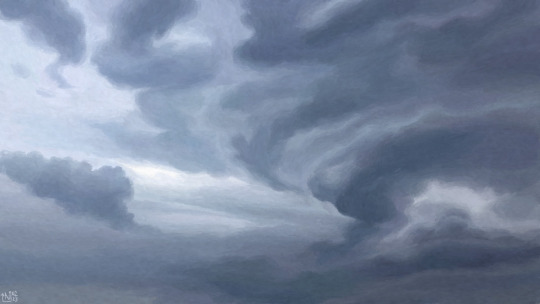
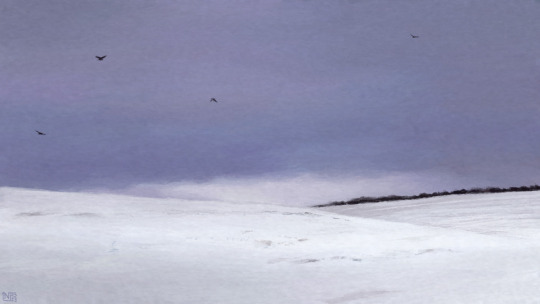
Cold winter skies illustrations for my daily meteorological fiction project, Reports From Unknown Places About Undescribable Events (Twitter, Instagram, Mastodon).
Keep reading for captions.
December 24th - We report: once again, we find ourselves under a murmuration as we walk past a field. We can hear trills and whistles coming from this massive bird cloud waltzing in the winter sky. We think there might be a few hundred of them, all moving together. We stay there for a long time.
January 10th - We report: the sky so dark and low this way, and the horizon so far, the trees bare and tiny in the distance; we wonder whether there might be space enough between the sky and the earth for us to walk. As it is, our face is up in the sky and our feet are down in the frozen earth.
January 13th - We report about this time, late in the afternoon when the humidity starts to saturate the atmosphere. Even through the dense clouds, there are faint hints of sunset colours amidst the grey. Blackbirds and sparrows are getting busy while we wait for the rain.
January 18th - We report Jupiter and Saturn at nightfall today; we expect Venus to follow shortly after, although the sky might be overcast by then. It is still too bright for us to be able to see stars, but we know that the Aquarius constellation is right there, rising over the horizon.
January 21st - We report: a morning removed from the world, fog and frost making even time move sluggishly. Every blade of grass looks brittle, and we wonder if they would snap off immediately, should we touch them. We cannot locate the sun, though we know where it should be.
January 25th - We report: the frothing winter sea during high tides; any colder and it would freeze solid, it would seem. There is an icy blue in the waves that unrelentingly crash against the rocky shore. The day stretches under an opaque sky that remains the same throughout.
January 30th - We report that we lost a glove on this snowy path, and we tried to walk back in our earlier steps. It was easy at first, but the snow and the night kept falling steadily; the footsteps disappeared. When we finally came home, though, our expert told us that they had picked it up.
February 13th - We report a very rare and complex halo display: a 20° halo, a parhelic circle with parhelia, a sun pillar leading up to an upper tangent arc and a parry arc, a 46° halo, and a circumzenithal arc. Very complex indeed, many arcs for a single sun. It is absolutely freezing outside.
February 22nd - We report: in the car, on a parking lot, facing the ocean. The rain is hitting the windscreen hard, in waves. It is an old car; the wind shakes it and whistles through the small cracks where the doors do not close very well. We watch raindrops run down the windows at an angle.
March 14th - We report: it has not stopped being cold here. We walk in the footsteps of someone who was here earlier this morning. It has snowed a little bit again since, and some of the tracks have been filled in. We are following a line of pollarded trees that creak in the cool wind.
#thursday was the 3rd anniversary of the reports project!!#very cool!!#never thought i'd ever reach that. never thought i'd make it to 30 days really#thank you so much if you follow the reports i appreciate it so much#drawing#digital#digital art#illustration#reports#artists on tumblr#weather#meteorology#snow#sky#clouds#birds#halo#circumzenithal arc#<- rare tag#frost#winter#night#long post#blue hour#clever reports#image description in alt text#sea#ocean#so many of these are from january
186 notes
·
View notes
Text

6 notes
·
View notes
Text
hey y’all i’ve been a meteorology nerd since i was 8 so i’m gonna talk about the cool meteorlogical shit i like
sundogs!!! this is when the sun looks like it has a smaller sun on each side of it like a little whore(affectionate). these happen when light refracts through ice crystals. the sun has to be on the fuckin horizon for this shit to happen, so this shit only happens at sunrise and sunset
circumzenithal arcs! these happen when you take a rainbow and turn it ass-over-tits. these little fuckers are also caused by light refracting through ice crystals and they happen really fuckin high up in the sky
fuckign. solar tornadoes!!! they’re caused by the sun’s hot flowing gas and magnetic fields. these fuckers are really goddamn fast- as in, they can reach speeds upwards of 180-FUCKING-THOUSAND MPH!!! they’re also the size of the gotdamn EARTH
rogue waves! these fuckers are a singular wave that’s at least twice as tall as the significant wave height(that’s the mean wave height for the area). they can be caused by one wave catching up to another, a wave reconnecting on the other side of an island, and plain old high-ass fuckin wind gusts
volcanic weather! some volcanoes create such a large cloud that they can cause their own weather! these include tornadoes and even fuckmothering rain
fire whirls! also called “firenadoes”, these little shits are caused by some of the same fuckery that causes solar tornadoes: hot-as-shit whirling gases. though these bitches also need some wind and a body of water covered in a flammable liquid to get going
THUNDERSNOW. yes, you read that correctly. thundersnow happens when the ground temperature is unusually warm during a snowstorm. there’s an epic video of well-known meteorologist Jim Cantore going absolutely batshit over experiencing this in Boston
#op reyvan#rey is a weather nerd#shut up rey#sundog#circumzenithal arc#solar tornado#rogue wave#volcanic weather#fire whirl#firenado#thundersnow#meteorology#science#excessive profanity#sophisticated as hell
4 notes
·
View notes
Text
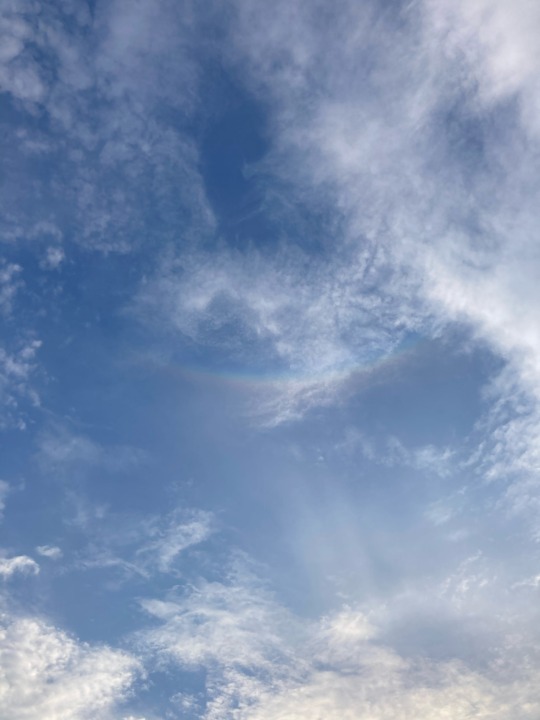
Circumzenithal arc late in the day 7/16/22
2 notes
·
View notes
Text



今朝5:20過ぎの空。
虹(左)と環天頂アーク(右)が少しだけ見えました。
0 notes
Photo

2023 December 20
Ice Halos over Bavaria
Image Credit & Copyright: Bastian Werner
Explanation: What's causing those unusual sky arcs? Ice crystals. While crossing a field of fresh snow near Füssen, Bavaria, Germany, earlier this month, the photographer noticed that he had entered an ice fog. For suspended water to freeze into an ice fog requires quite cold temperatures, and indeed the air temperature on this day was measured at well below zero. The ice fog reflected light from the Sun setting behind St. Coleman Church. The result was one of the greatest spectacles the photographer has ever seen. First, the spots in the featured picture are not background stars but suspended ice and snow. Next, two prominent ice halos are visible: the 22-degree halo and the 46-degree halo. Multiple arcs are also visible, including, from top to bottom, antisolar (subsun), circumzenithal, Parry, tangent, and parhelic (horizontal). Finally, the balloon shaped curve connecting the top arc to the Sun is the rarest of all: it is the heliac arc, created by reflection from the sides of hexagonally shaped ice crystals suspended in a horizontal orientation.
∞ Source: apod.nasa.gov/apod/ap231220.html
161 notes
·
View notes
Photo

Ice Halos by Moonlight : An almost full moon on April 15 brought these luminous apparitions to a northern spring night over Alberta Canada. On that night, bright moonlight refracted and reflected by hexagonal ice crystals in high clouds created a complex of halos and arcs more commonly seen by sunlight in daytime skies. While the colors of the arcs and moondogs or paraselenae were just visible to the unaided eye, a blend of exposures ranging from 30 seconds to 1/20 second was used to render this moonlit wide-angle skyscape. The Big Dipper at the top of the frame sits just above a smiling and rainbow-hued circumzenithal arc. With Arcturus left and Regulus toward the right the Moon is centered in its often spotted 22 degree halo. May 15 will also see the bright light of a Full Moon shining in Earth's night skies. Tomorrow's Full Moon will be dimmed for a while though, as it slides through Earth's shadow in a total lunar eclipse. via NASA
590 notes
·
View notes
Text
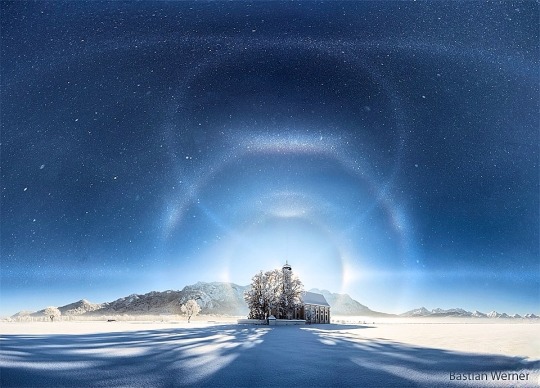
SPACEMAS DAY 23 ✨🪐🌎☄️☀️🌕
Since it’s officially winter now (in this hemisphere at least) I thought this picture for today would be fitting!!
What's causing these unusual sky arcs? Ice crystals! While crossing a field of fresh snow near Füssen, Bavaria, Germany, this photographer noticed that he had entered an ice fog. For suspended water to freeze into an ice fog requires quite cold temperatures, and the air temperature on this day was measured at well below zero. The ice fog was reflecting light from the sun setting behind St. Coleman Church. The result was this spectacular image. First, the spots in the featured picture are not background stars but suspended ice and snow. Next, two prominent ice halos are visible: the 22-degree halo and the 46-degree halo. Multiple arcs are also visible, including, from top to bottom, antisolar (subsun), circumzenithal, Parry, tangent, and parhelic (horizontal). Finally, the balloon shaped curve connecting the top arc to the Sun is the rarest of all: it is the heliac arc, created by reflection from the sides of hexagonally shaped ice crystals suspended in a horizontal orientation.
Image Credit & Copyright: Bastian Werner
#astronomy#space#science#universe#spacemas#day 23#Germany#ice crystals#suspended ice crystals#sky arcs#sun#reflection#beautiful#stars#earth#wow#follow#like#reblog#the first star#the first starr#thefirststar#thefirststarr#nasa#apod#tumblr#blog#space blog#halo#ice halo
48 notes
·
View notes
Text

A couple of circumzenithal arcs captured at Smuggler’s Notch VT
42 notes
·
View notes
Text

Different types of rainbows
Did you know there are different types of rainbows? Us witches love our correspondences, so in Rainbowmancy we can tap into each of these rainbow energies to charge items or power our magic.
Primary rainbow: Our beloved rainbow. Rain droplets catch sunlight which creates a prismatic effect, causing the arc of colours to appear. In a primary rainbow we see red on the outer edge of the arc, and violet on the inner edge. A rainbow is actually a circle, but we are most often too close to the ground to see it in its entirety. Higher up this "full circle rainbow" as it's called, becomes visible
Double rainbow: This is when a, usually paler, secondary rainbow appears above of our primary rainbow. The second rainbow has their colours reversed, with violet on top and red in the centre.
Twinned rainbows: Here the two rainbows are not stacked, but instead appear to begin at the same base, splitting off from there. Where with the double rainbow the colours are reversed, the twin rainbow has the same order of colours as the primary rainbow.
Monochrome rainbow: A very dramatic looking rainbow in just red. This happens when there is a rain-shower at sunset or sunrise.
Supernumerary rainbows: Also knows as "stacker rainbow" or "supernumerary bands". Here bands of pastel rainbow colours appear just below the inner arc of the primary rainbow. The colours are more pastel, and keep repeating, fading the further away from the arc they go. Rarely supernumerary bands can also be stacked on the top of the primary rainbow.
Reflected rainbow: When the primary rainbow is reflected in a body of water, even as small as a puddle. After deflecting in the raindrops the light reflects off of the water.
Reflection rainbow: Here the light first reflects off of a big body of water before deflecting in the raindrops. Reflections of the primary rainbow can be seen, sometimes up to eight in number!
Fogbow: These rainbows are made when the light is refracted in the tiny droplets of fog or mist. Because of the dispersion they are mostly white, with some reds and blues. The bands of colour are broad, but very muted. They often appear with a Glory in the centre (see below).
Moonbow: Not only the light of the Sun can bring a rainbow, the light of the Moon can as well! This is rare, and requires the moon to be close to full. Our human eyes often see the moonbows as white, for we can't see the colours, but they are there.
Snow rainbow: Also known as a sleet rainbow. These look like primary rainbows, however here the light is refracted through ice pellets instead of liquid raindrops. Sleep rainbows can also have double, twinned, monochrome, and other forms of rainbow.
Other optical phenomena that are similar to rainbows, but not actually rainbows:
Circumhorizontal and circumzenithal arcs: This happens when light is refracted in hexagonal ice crystals instead of raindrops. The circumhorizontal arc is more flat than the circumzenithal arc, which looks almost like an upside down rainbow. Both have the red parts of their arc pointed towards the Sun (or Moon).
Glory: This appears around a shadow cast in mist of fog. The reflection in the tiny droplets causing a multicoloured halo to appear around the shadow. The "halo" starts with red and ends with blue, repeating itself and growing less bright with each repeat.
Rainbow spiderwebs: Dew catches on the strand of a spiderweb. The droplets then refract light, creating a glowing rainbow web of colours
Cloud iridescence: An optical phenomenon that occurs when thin clouds close to the Sun or Moon contain water droplets or ice crystals that are roughly the same size. The light is refracted within the cloud which creates repeating bands of colour.
Iridescence: Also known as goniochromism. Iridescence means "having a tendency towards rainbows", meaning that although they are not truly rainbows, their colouring does remind us of it. It is an optical phenomenon where the colours shift depending on in which angle the light hits it. Very thin layers of the surface then refract light back in different wavelengths, making it appear to shift colour and have multiple colours. Examples are soap bubbles, oil slick, feathers, butterfly wings, and certain crystals, such as opals.
Pearlescence: The same phenomena as iridescence, but most of the light reflected back is white.
[Part of a Rainbowmancy series, masterpost here]
8 notes
·
View notes
Text

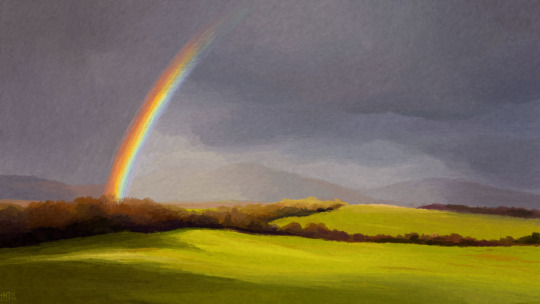
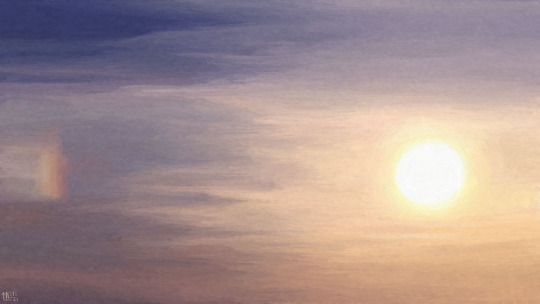
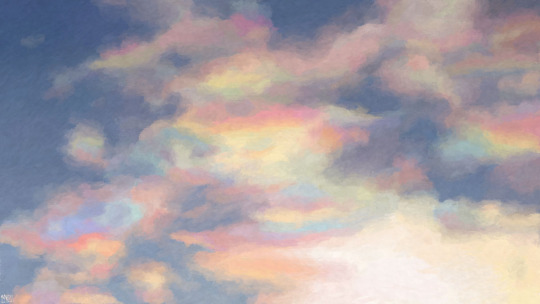
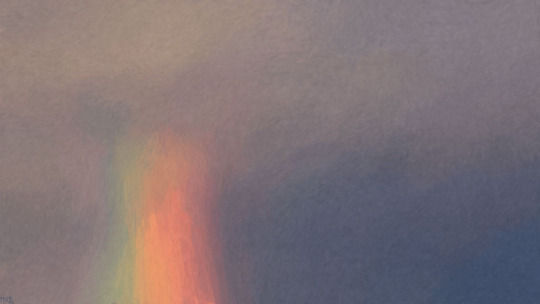
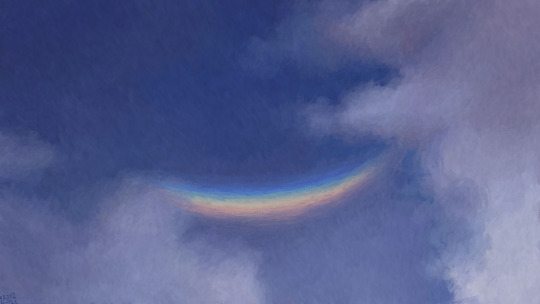




Illustrations of rainbows, sundogs, iridescences, and circumzenithal arcs from my daily meteorological fiction project, Reports From Unknown Places About Undescribable Events (Twitter, Instagram)
Keep reading for captions.
August 12th, 2021 - We report: we feel, ever stronger each time, the impulse to stop everything we are doing when we spot a rainbow. We stare at the way the light hits the rain for as long as we can to see it gently wobble. We notice it intensifying and weakening before it disappears.
October 14th, 2021 - We report one of the numerous rainbows that we have had the chance to witness lately. Rainbows occur most frequently in rainy situations, interestingly enough. There are fewer chances of a rainbow appearing if there is no rain going on at all. Absolutely fascinating.
November 5th, 2021 - We report: just a little sundog that appeared and disappeared very quickly. We looked for it for too long after it faded away, and we can now see red and green spots everywhere we look. Staring directly at the Sun is not a great idea, but we keep making the same mistake.
November 17th, 2021 - We report that we wanted to look at these clouds that were drowned in sunlight, and so we covered the Sun with one hand. When we looked up, right here, hidden in plain sight, these clouds were rippling with the whole colour specter.
January 5th, 2022 - We report: we can not count how many times either we or our expert have called "rainbow!" and eagerly pointed at the sky as though it would immediately disappear if we looked away. It is hard to even blink in the presence of rainbows.
February 4th, 2022 - We report a circumzenithal arc, a swipe of rainbow far above the Sun; these occur thanks to some flat and hexagonal ice crystals in the highest parts of the troposphere. Unlike our usual rainbows, their colours start with blue and end with red. Also, they look like smiles.
March 23rd, 2022 - We report: the human eye can only perceive so many frequencies of light, but they feel like an infinity when we are looking at a rainbow. Every nanometer of wavelength we can see is worth cherishing.
April 23rd, 2022 - We report: this is a small bit of a cloud, and an even smaller bit of the sky. To really see it, we had to block off the Sun with one hand, and then - only then were we able to see what makes this minuscule part of the sky so special.
June 20th, 2022 - We report a thunderstorm that skirted around the town. We counted the seconds between lightning and thunder on our fingers, trying to do the math to determine how close the storm was, until there was no lightning. Then, the thunder too boiled down to a low rumble in the distance.
September 11th, 2022 - We report: it is not about loving the sun, the sun simply is. There is nothing without the sun. But on days when rainbows appear - we can see the light shimmer through the raindrops, the rain falls heavier, and the sun shines brighter (and we do love the sun in this moment).
#drawing#digital art#digital#illustration#artists on tumblr#clouds#landscape#sky#weather#rain#reports#meteorology#autumn is rainbow season let's go!!#text#image description in alt text
185 notes
·
View notes
Text
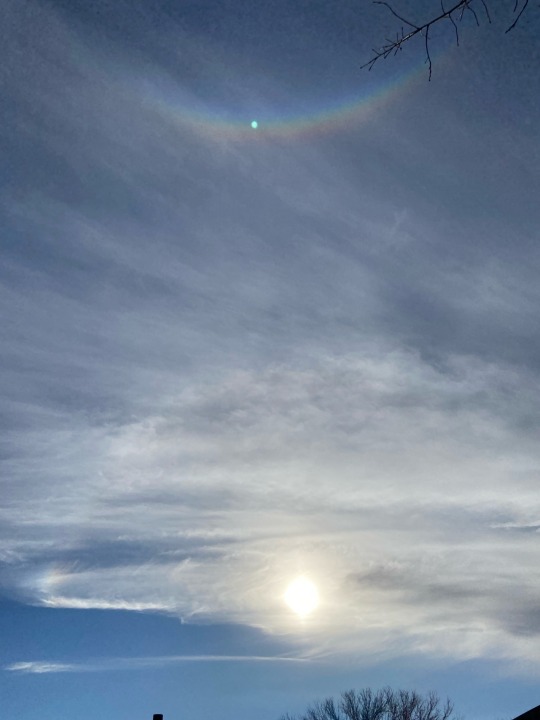
Small parhelion to the left of the sun, circumzenith arc above my head
2 notes
·
View notes
Text
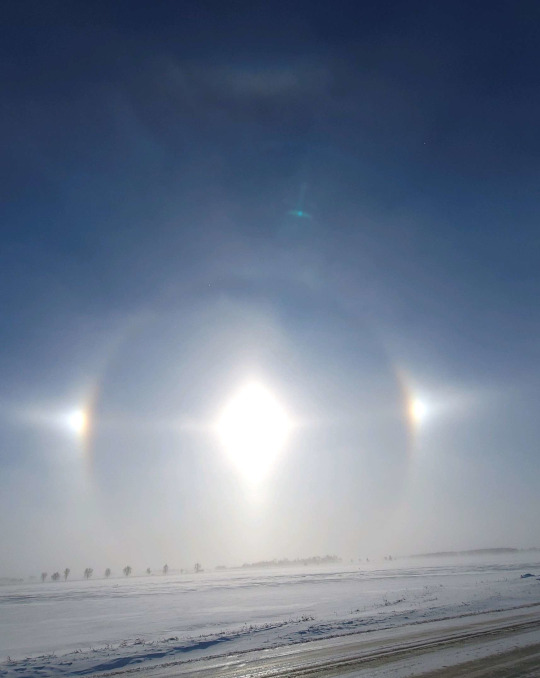
Here is a Halo Display I took some pictures of the day before the big storm on Christmas, the extreme cold and high wind speed picked up a large amount of snow and ice, which refracted the sunlight according to the structure of the ice, resulting in several common halos and one weird one.
Pictures below show the annotated image and a guide to Halos I put together last year.
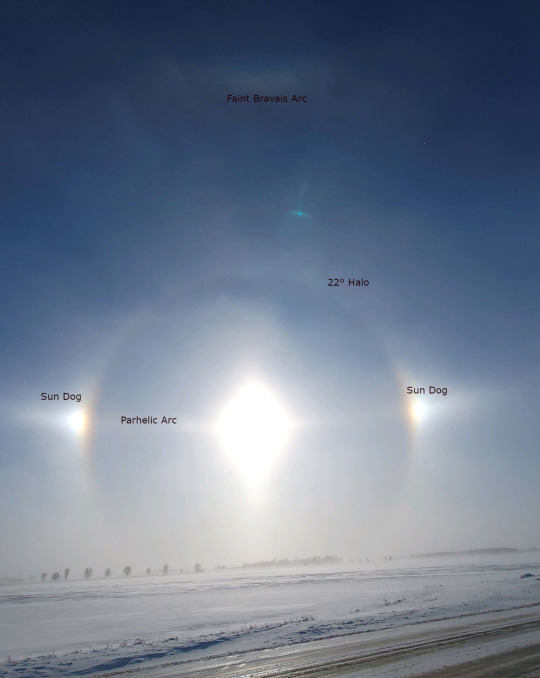
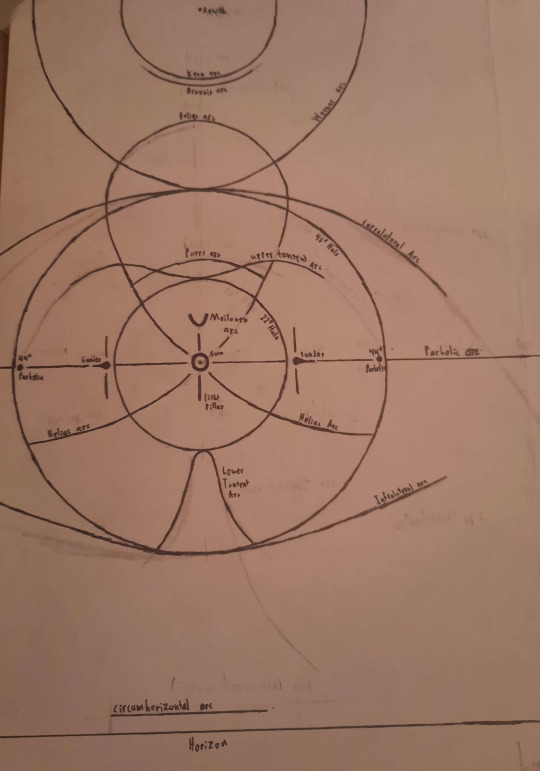
In this display are the following:
Sun Dogs (Parhelia) - The most common halo component, formed as sunlight is refracted through plate shaped hexagonal ice crystals gently floating downwards.
22° Halo - Another common halo, forms as light is refracted through hexagonal plates in a state besides being completely flat, resulting in a ring around the sun at the same distance as the sun dogs.
Parhelic Arc - A less common halo caused by reflection off of the surface of ice crystals rather than refraction. This particular instance only stretched through the sun rather than all the way around the sky, which is common when it appears at all.
Bravais Arc (Circumzenithal Arc) - A reasonably common halo that has a reputation for being rare since it is seen at such a high altitude compared to others. This halo forms a rainbow arc in a circle around the zenith when the sun is at most 30° above the horizon. Caused by light entering the top of a hexagonal ice crystal and exiting through its side, resulting in a separation of colors.
#halo#sun dog#sorry if this shows up in the halo video game tag#there wasn't any other tag I could find
6 notes
·
View notes
Photo

Ice Halos by Moonlight via NASA https://ift.tt/z1WC8DA
An almost full moon on April 15 brought these luminous apparitions to a northern spring night over Alberta Canada. On that night, bright moonlight refracted and reflected by hexagonal ice crystals in high clouds created a complex of halos and arcs more commonly seen by sunlight in daytime skies. While the colors of the arcs and moondogs or paraselenae were just visible to the unaided eye, a blend of exposures ranging from 30 seconds to 1/20 second was used to render this moonlit wide-angle skyscape. The Big Dipper at the top of the frame sits just above a smiling and rainbow-hued circumzenithal arc. With Arcturus left and Regulus toward the right the Moon is centered in its often spotted 22 degree halo. May 15 will also see the bright light of a Full Moon shining in Earth's night skies. Tomorrow's Full Moon will be dimmed for a while though, as it slides through Earth's shadow in a total lunar eclipse.
(Published May 14, 2022)
9 notes
·
View notes

